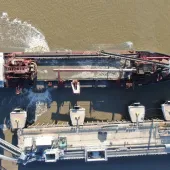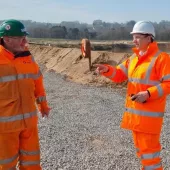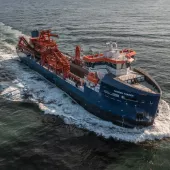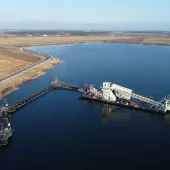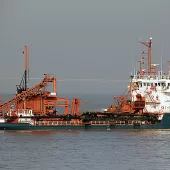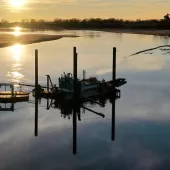Freight By Water

Land & Water look forward to a return to the golden age
The idea of freight returning to the 2,800 miles of navigable waterways crossing the UK has, for many years, been little more than a wistful dream thought up by those who hark back to a distant past when shire horses pulled barges from the towpath. In recent years, however, various interested parties have been taking a serious look at how the canals and waterways could once again be opened to freight transport.
The high-profile launch, by British Waterways in 2003, of a scheme using barges to transport 450,000 tonnes of sand and gravel between Denham and West Drayton, thereby removing 45,000 lorry loads off the road over a seven-year period, went some way towards illustrating that it was indeed possible for a return to carrying freight on smaller waterways, albeit with limited applications.
However, during the last five years, huge steps have been made in the development of water transport and British Waterways’ partner in the Denham project, Land & Water Group, has now designed and built a high-capacity barge that makes freight transport on canals an environmentally and financially viable alternative to road haulage.
A framework dredging contractor for British Waterways since 2001, Land & Water were instrumental in the design and ongoing management of the entire Denham project from launch to the present day. They have first-hand experience of the limitations of operating on inner-city canals and many lessons have been learnt since the launch of the original barges designed to carry the sand and gravel quarried at Denham.
As with any waterway, canals need to be maintained in order to keep them operational and British Waterways undertakes an extensive programme of dredging and maintenance throughout the year. Despite this, traditional barges are limited as to the weight they are able to carry, not only by the depth of the canal, but also the amount of water a fully loaded barge displaces. In order for freight by water to be a viable, cost-effective option, a special barge must be designed and built to cope with the unique conditions found in the waterways around the UK.
‘The original concept for Denham was sound, and the unique bow configuration has gone a long way to minimize wash and disturbance on the waterway,’ commented James Maclean of Land & Water Group. ‘However, while the canal meets modern leisure craft navigational standards, the waterway profile is still reduced from that its original commercial cross section.
‘By using a high-displacement barge, the vessel can suffer from ‘restricted water syndrome’, a phenomena first identified on the approaches to locks on the Panama canal, where high displacement vessels ‘hogg’ or ‘squat’ on to the waterway bed, as water cannot freely reach the propulsion at the stern of the vessel.’
Learning from this, Land & Water have developed a new Olympic-class hopper barge to operate on waterways that may suffer the same syndrome. The new lightweight vessel is extremely shallow-drafted, taking advantage of Land & Water’s lightweight hull and single-skin floor design, and with a bow and stern that adopts the Denham hopper barge principle. As a result, Land & Water can now carry in excess of 85 tonnes at an operating draft of under 1.37m (4ft 6in – the leisure craft navigation depth).
‘This achievement unlocks all sorts of opportunities around the UK, and notably on London’s waterways,’ said Mr Maclean. ‘But to provide a truly integrated transport solution, we have designed the vessels to be rafted in groups of up to six, and when loaded to 75 tonnes capacity each, they are in-class for navigation up and down the tidal reaches of the river Thames and other similar category tidal waters. This eliminates the need for expensive transhipment, and opens a variety of avenues for multi-modal and multi-material transport.
‘To take the concept even further, we have included provision within the hold of the barge for a grillage to carry ISO container boxes, which makes the carrying possibilities endless.’
The Olympic barge has been pressed into immediate action in a partnership with Powerday plc, one of the UK’s largest and most forward-thinking waste-management companies. Over the past two years Powerday have invested over £12 million in a state-of-the-art recycling centre, based at Old Oak Sidings, Park Royal, on the outskirts of London, which is able to convert all forms of industrial and domestic waste into a series of reuseable materials.
Once separated, all the various waste constituents are processed, making this site one of the very few in the country that can genuinely claim to usefully recycle and reuse every constituent that comes through its gates. Waste wood is chipped and used at Slough power station to produce energy, nails are sold as scrap metal, plastics are separated and shredded before being processed for waste-to-energy, concrete is reduced to reclaimed aggregates and waste soils are recovered for re-use as a restoration material at a remote landfill site, which is accessed directly by train from the site.
The recycling centre is based on the Grand Union Canal, and Powerday have installed a 75m long quay to accept barges up to 90 tonnes fully laden. The combination of a custom-designed barge and waterside recycling plant has made the concept of canal transport a genuine commercial option, and Land & Water and Powerday have formed a commercial agreement to jointly market and develop their multi-modal and sustainable solutions for waste streams and building materials in central and west London.
Mick Crossan, chairman of Powerday plc, commented: ‘Freight transport by water has always been something of a pipedream, but the introduction of the Olympic barge has now made it possible for waste to be transported from multiple sites within London to the recycling plant here at Old Oak Sidings. It is a very exciting development.’
However, it is the long-term potential which is really exciting the various parties involved. The Regents Canal links with the Grand Union, which passes through the heart of London, and, in turn, joins up with the Olympic site at Leytonstone, in east London. In an age when pressure is on contractors to reduce traffic and pollution in the capital, freight transport by canal is now a viable alternative.
It is already possible for all forms of waste to be loaded into the barge at various collecting sites across the capital and transported along the canal network to the processing plant at Old Oak Sidings, at a competitive cost to conventional alternatives, and without the environmental impact that more traditional road haulage would have.
In addition, Land & Water have entered into partnerships with marine towage specialists GPS Marine Contractors Ltd (for tidal vessel movements on the Thames), and with S. Walsh and Sons (landfill and recycling operators in the east Thames Corridor), as well as a number of landfill operators in this area, to provide a one-stop shop for east London and Thames-side projects.
With the ability to haul large amounts of freight along a network of canals that is ready and waiting to be utilized, the Olympic barge could prove to be the answer for all those who dream of a return to yesteryear.

